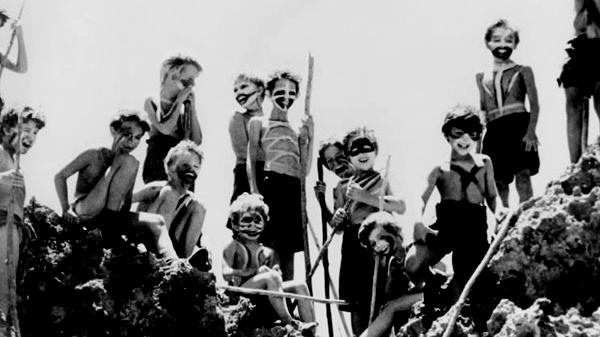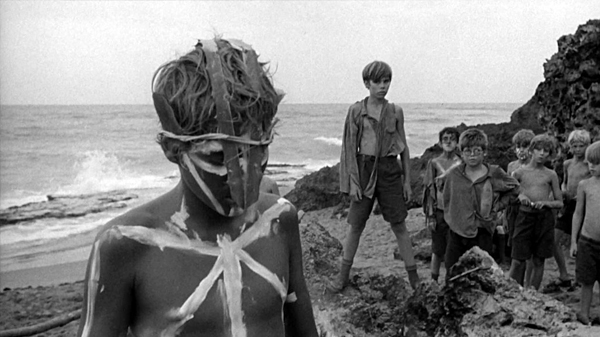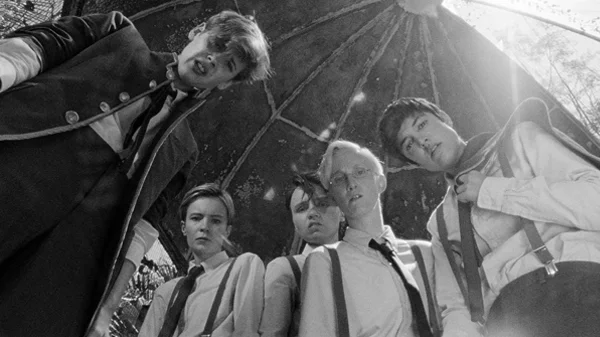The heady experience of the isolation of teenage boys comes to the fore in Bertrand Mandico’s The Wild Boys, but its roots in Peter Brooks’ 1963 adaptation of Lord of the Flies are inescapable. Through black and white photography and feverish examinations of gender conventions, Fiona Underhill explores the pair’s parallels.
Experimental filmmaker Bertrand Mandico made his feature-length debut with Les Garçons Sauvages (The Wild Boys) and it has every possible hallmark of pretension – French, black-and-white, sexy, unconventional and impressionistic. It was also one of the best films of 2018, and almost no one saw it. The story focuses on a gang of violent teenage boys who commit a horrific crime. Their bourgois parents employ the services of a Dutch Captain to take the boys to work on a boat at sea for two months, to rehabilitate them - promising to make them docile and obedient. They make a stop at a mysterious island with magical properties - it contains fruits which have a ‘feminising’ effect. The crucial and unique quality of the film is that the “wild boys” are played by young women.
As an (admittedly slightly odd) teenager, I became obsessed with Peter Brook’s film adaptation of Lord of the Flies (1963), before I had read the book. When I was 16, a documentary was televised, which showed Brook and the actors who played the boys reuniting on the island on which they filmed, 35 years later. For some reason, this fascinated me - the blurring of actor and character, Brook’s concern about the lasting impact he’d had on the boys’ lives. When I studied drama at University, Brook became one of the main theatre practitioners we learned about – when I discovered it was the same man who directed Lord of the Flies, it blew my mind. I later went on to teach in an all-boys’ school for ten years, and teaching Golding’s Lord of the Flies in this environment offered a real highlight.
Watching The Wild Boys, the influence of Lord of the Flies jumps out immediately – Mandico describes it as ‘the matrix film to The Wild Boys’. Beyond obvious thematic comparisons, both directors chose to film lush tropical islands in stark black and white, which brings the violence and barbarism into sharp relief. Mandico was also influenced by Lynch’s use of black and white in The Elephant Man – the juxtaposition of beauty and cruelty highlighted by the contrast of crisp monochrome. Mandico opens and closes the film on the black beaches of the volcanic island of La Reunion, focusing on the character of Tanguy, who has white-blonde hair, emphasising his resistance to the island. Robert Mapplethorpe’s black and white photographs of phallic flowers – blending worlds of nature and eroticism - surely influenced Mandico’s decision-making. There is a shot at the end of The Wild Boys, as Tanguy becomes consumed by the island, that could have been taken by Mapplethorpe.
The photography makes the characters’ features and clothing contrast with their environs – Simon in LOTF with his white-blonde hair shining amongst the dark foliage, Jean-Louis in TWB with his black hair and black eyes – arrogantly and charismatically commanding the camera’s attention. The boys in both films wear school uniforms – Jack’s choir have black cloaks – forming a dark snake-like creature across the white sand, aligning them with the beast from the start. At the end of TWB, Jean-Louis commandeers the Captain’s hat, fully taking on the rebellious look of Kenneth Anger’s Scorpio Rising (a major influence on Mandico). The black and white cinematography highlights their military-style clothes, epitomising the rigid societies the boys have come from and how they are broken down by the wild nature around them. The choice of black and white also works metaphorically, as both films explore dichotomies – in Lord of the Flies, it is civilisation vs. savagery and in The Wild Boys, male vs. female.
In Lord of the Flies the group is divided, with Ralph and Piggy on one side – who represent democracy, peace, rules and rationality. In opposition are Jack and Roger – who stand for dictatorship, war, tribalism and impulsive violence. On his own is Simon, an innocent Christ-like figure. Ralph and Piggy complete the traditionally feminine and maternal jobs of building shelters and caring for the younger boys. Jack and Roger take on the stereotypically masculine duty of hunting – both to provide meat and to defend against the beast. The irony, of course, is that Jack and Roger become worse than any beast, and their inherent savagery is eventually revealed by the island. Brook’s film is more a triumph of casting than acting – only James Aubrey, who plays Ralph, went on to continue acting. The fact that the boys were mostly expats and ‘military brats’ assisted with the development of their characters, as they were used to moving schools and quickly fulfilling their role within a group hierarchy. Hugh Edwards’ intonation and delivery aptly conveys Piggy’s slow, plodding, exasperating nature.
The Wild Boys do not fall into the same neat archetypes as those in LOTF – there is the profoundly cruel and dominant Jean-Louis (Vimala Pons), the blonde/bespectacled Tanguy (Anaël Snoek), the young and sweet Sloane (Mathilde Warnier) and careless Romuald (Pauline Lorillard). Lastly, there is the secretive Hubert (Diane Rouxel), who develops Stockholm Syndrome – firstly with The Captain, then with Severine (a mysterious woman who is at one with the island). In a just world, The Wild Boys will offer a star-making turn for Vimala Pons, in particular. The physicality she brings to the role of Jean-Louis effectively embodies an arrogant teenage boy, swaggering around with his hands in his pockets – looking down on everyone, regardless of height. Snoek also delivers a nuanced performance as Tanguy, who (perhaps surprisingly) is the most resistant to the feminine pull of the island. The film begins and ends with him, and the whole story feels like Tanguy’s feverish nightmare.
In The Wild Boys, the gang’s wealthy parents acknowledge that they are “erudite at will, but they are barbarians”. The parents want the boys to be carted off and cured (as with forced conversion therapy), so they don’t have to deal with them. The Captain believes he can change the boys’ violent behaviour by making them feminine through the use of a ‘magical cure’, which Severine has found on the island. Lord of the Flies focuses on an extreme situation revealing the dark side of human nature which lies dormant within, waiting to be revealed once the strictures of polite society have been stripped away. In The Wild Boys, the evil within is already out there for all to see – Mother Nature is supposed to have a calming effect on them, rather than enhancing their savagery.
Bertrand Mandico has created a heady, delirious whirlwind of a film with The Wild Boys; with exceptional performances, stunning visuals and an examination of the pull between the masculine and feminine which exists within us all. The existence of The Wild Boys makes the entire concept of an ‘all-female reboot of Lord of the Flies’ that was mooted a year or so ago even more ridiculous than it already was - because the best version it could be already exists.
Fiona Underhill (@FionaUnderhill) is a freelance film and TV writer. She is the Content Editor for Jumpcut Online. She has contributed work to CC2K Online, Moviejawn, much ado about cinema and more, she is a member of WFCC and The OAFFC.
READ ME is a platform for female-led writing on film commissioned by Girls on Tops. Louisa Maycock (@louisamaycock) is Commissioning Editor and Ella Kemp (@efekemp) is Contributing Editor.





